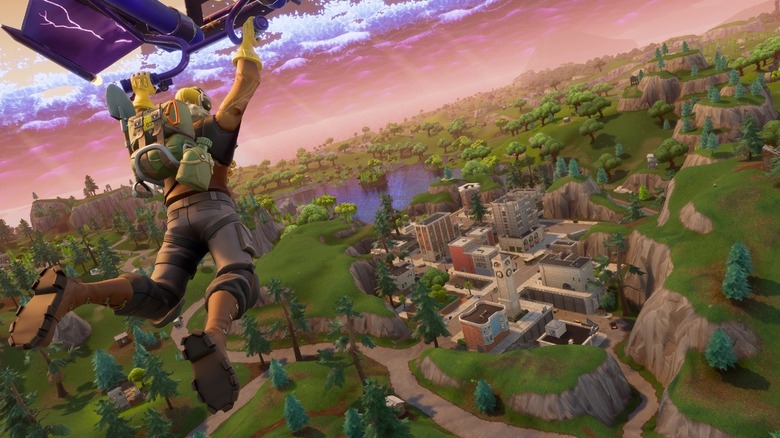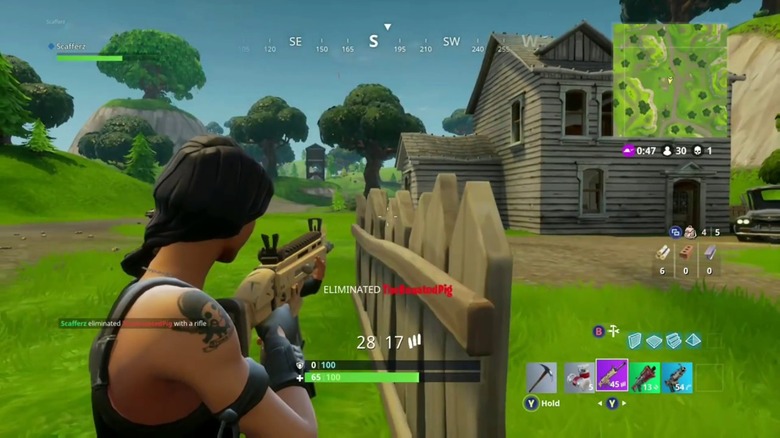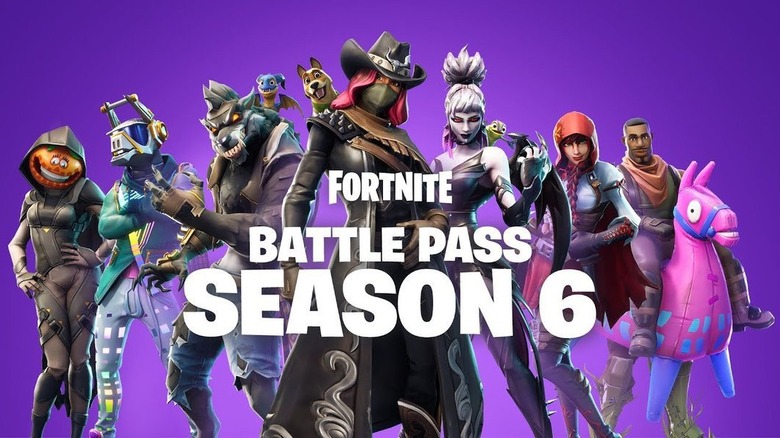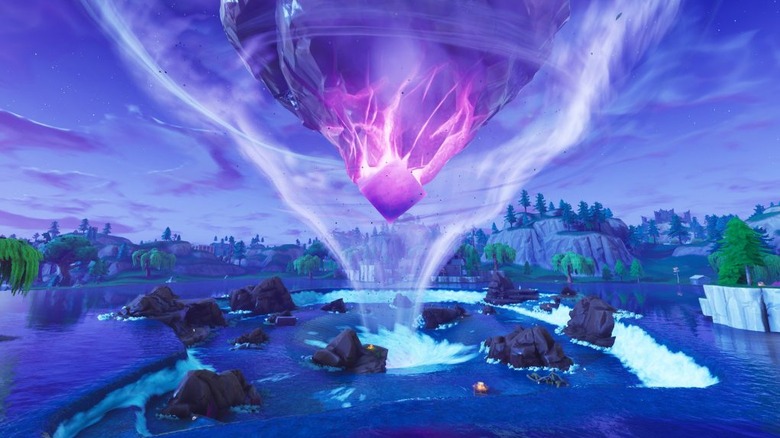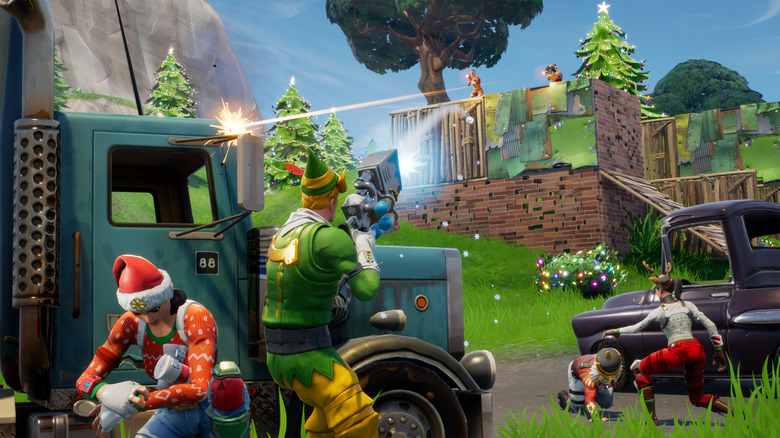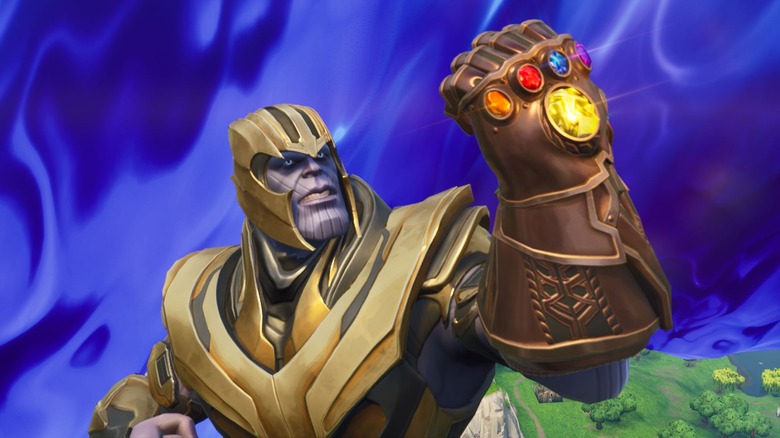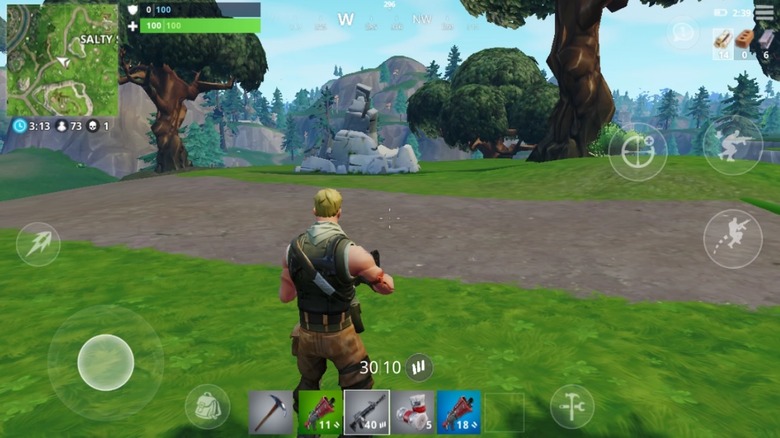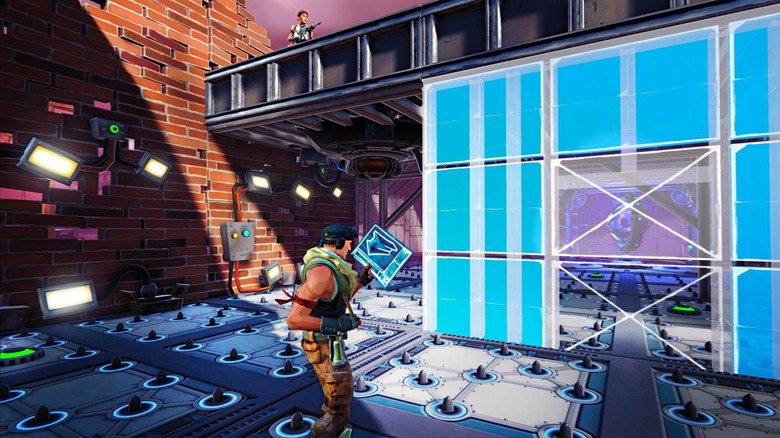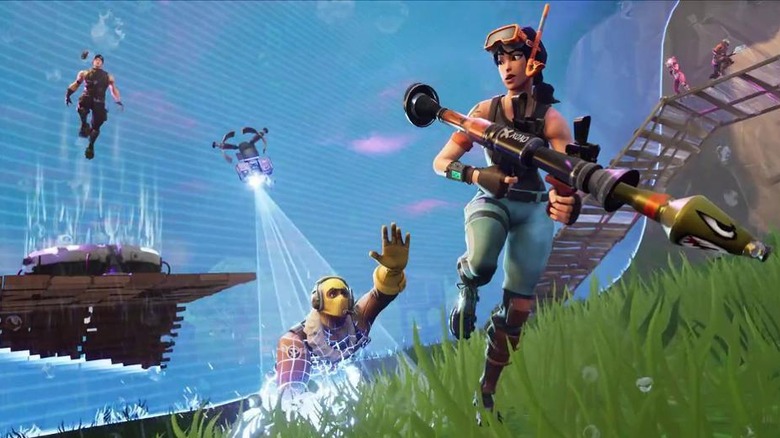What Other Games Can Learn From Fortnite
Whether you're a fan of Fortnite or exhausted of hearing the game's name, it's impossible to deny that it has had an immense impact on the gaming industry. Fortnite's sheer size has not only helped birth a whole new mainstream gaming genre, but potentially a whole new extension of the industry itself. The battle royale game is a multi-billion-dollar property with a following most AAA games can't even come close to (125 million players, which, if one were to overlook bots or players with multiple accounts, would mean roughly one out of every 59 people in the world has played Fortnite), a feat this game achieved in under a year.
That kind of unprecedented growth and subsequent success isn't a sign that Epic Games is following the usual AAA strategy of derivative sequel production and release-'em-and-leave-'em sixty-dollar retail boxes. Fortnite's rise to prominence is a clear indicator that Epic Games is carving its own path to dominance and rewriting the rules of how to make a successful AAA game. Here are some of the interesting strategies, ideas, and concepts other games, developers, and publishers can learn from Epic Games' Fortnite.
Tactical trend-hopping
There's an unspoken rule with trends: it's never good to be the first guy to start it (PlayerUnknown's Battlegrounds), because then you're the test run. And it's even worse to be the third guy (Radical Heights), because then you're late to the party. But if you're fast enough to be the second guy (Fortnite), you can iron out all the kinks in the first guy's model and dominate the niche before guy number three ever gets a shot at the big time. That's exactly what Epic Games did, by stealing PUBG's thunder and leaving Radical Heights as nothing more than a footnote in battle royale genre history.
Fortnite made sure to get a few key things right that PUBG failed at: first, Fortnite released in a pretty stable, functional form, unlike the unoptimized and graphically unambitious PUBG. Fortnite also knew not to sell itself for cash upfront, unlike PUBG, which charged $29.99 just so players could gain entry to a buggy, unfinished early access game. Launching a strong product out of the gate with no financial barrier to entry was likely the biggest factor in Fortnite's acquisition of a massive player base that quickly eclipsed that of PUBG's. And from there, a bunch of other smart moves on Epic's part (which will be discussed below) made sure to keep Fortnite top dog, so that it could snuff out and utterly decimate whoever showed up next to the battle royale party, e.g., Radical Heights.
Copycatting is A-okay (if it's done with a little flair)
Contrary to the claim that brand-new ideas and original concepts are the lifeblood of the gaming industry, the reality is that a profitable or critically lauded (or both) game can be a simple copycat of another game as long as it's got a few smart twists to keep things fresh. Consider how the best-selling Halo and Battlefield series have been quietly aping more and more of Call of Duty's trademark twitch-reflex, low-skill-floor shooter gameplay over the past few years, all while consistently putting their own spin on things enough to differentiate themselves. The gaming industry's all about (not really) caring and (involuntarily) sharing, so long as no one shares too much at once.
Fortnite nailed this idea. It takes the fundamental appeal of PUBG's 100-player, (initially) one-map battle royale DNA, and fuses it with structure-building gameplay, a wildly different aesthetic, a different pay model, and so many more differences that calling Fortnite nothing more than a cheap copycat would be doing the game a sizable disservice. It knew not to mess with the core concept, but it added layers on top of it and removed some barriers to entry, making it the differentiated "remix" of PUBG that was more affordable, accessible, and entertaining for many consumers.
Free-to-play evolved
Gone are the days where $60 buys you a game and you must fork over an additional $50 for the season pass. We've now entered the world of freemium AAA products, wherein you pay nothing to play but are heavily incentivized to pony up small increments of cash for equally small rewards. As mobile and MOBA gamers are familiar with, this payment model revolves around microtransactions, wherein a company charges you a few bucks for in-game currency that you can spend on game-specific items (characters, costumes, customizations, etc).
Fortnite has this monetization system implemented in-game under the title of "V-bucks," a digital currency that costs real-world money. Epic Games has managed to make this fictional currency attractive enough that companies are using it as a pre-order incentive, such as for tech like Samsung's Galaxy Note 9 and the Nintendo Switch.
Impressive as that is, where Epic Games takes things to the next level is in its implementation of the Battle Pass, wherein you can pay roughly $10 to boost your rewards for the duration of an in-game season. There's a lot of mathematical tom-foolery involved in this pass, but the gist is that you'll be able to complete more challenges and unlock cooler rewards over the course of multiple months in Fortnite for one flat price. It's a smart, enticing alternative to the game's individual item purchasing system, which charges ludicrous amounts for cosmetics, such as $20 for a single costume.
Surprise events keep things fresh
Fortnite isn't like some other multiplayer-centric products, which rope in an audience solely to ditch them after a year in favor of pushing the next game in line. Fortnite's in it for the long haul with its community and is taking great pains to keep things interesting. Chief among said pains are the surprise events Epic Games keeps unveiling. There's been a comet that flew over the in-game arena for quite some time before finally crashing and becoming a massive crater that changed map design and gameplay. Then there was an Avengers: Infinity War event that brought Marvel's Thanos to Fortnite's world, wherein players had a limited time to try and snatch the Infinity Gauntlet in order to play as the mad titan. After that, as if gamers hadn't already received enough seasonal shakeups and exciting diversions, Epic introduced "the cube," a big, purple box that rolled across the map, affecting terrain and providing intrigue. And even that evolved into something more.
Epic Games uses these events as a smart, exciting way to lure people back to the game and keep current players invested. These events also provide Epic with free publicity thanks to outlets such as ours, which cover each new bombshell development in Fortnite. Be it a comet, crater, cosmic conqueror, or cube, Epic knows the key to maintaining a thriving multiplayer community is in keeping the in-game world just as alive and unpredictable as the player base.
Kids love wacky aesthetics
Let's be honest: Fortnite is aesthetically designed to appeal to children and tweens. Its color palette is vibrant and popping, its character models and animation styles are goofy and cartoonish, its emotes are quirky and "lol so random" in a way that's entirely youth-targeted; need we go on?
Sure, there are tons of adults who've gotten into the game, but that's the case with any kid-focused property. Look at Minecraft! Sure, all ages can partake in and enjoy it, but it's marketed primarily to rope in kids with its LEGO-like design. Similarly, Fortnite's appearance enables it to cast a wide net that makes it acceptable for anyone, but it's clearly designed to be more enticing for younger gamers. That's important, because younger gamers are the ones with lots of time on their hands, and, more often than not, are the demo that's worth billions thanks to their proximal relation to parents' credit cards.
Is it kind of sinister that the game is clearly designing itself around the idea of selling stupid virtual dance moves to kids for tens, if not hundreds, of dollars? Sure. Epic is a business, though, and knows how to rake in the dough by preying on kids' whims and lack of understanding about the value of money. Just like Willy Wonka knew that most kids flock to zaniness like moths to a lamp, so does Epic.
Cross-medium brand synergy
Epic Games knows how to win over people who couldn't care less about Fortnite. It has done so via its own cross-brand promotions, as well as quietly reaping the rewards of the publicity its own fans are producing entirely of their own volition. Case(s) in point: Thanos and Drake.
Thanos' arrival in Fortnite, courtesy of Epic and Marvel teaming up for some good ol' Avengers: Infinity War promotion, was a huge moment for the game. It got the attention of everyone, including comic fans, movie fans, and Marvel superhero fans who'd been waiting years for some sort of true AAA Marvel superhero game (since Marvel's not been super active in the AAA scene for quite some time). In this way, the tie-in promotion satisfied all three demographics, each of which likely contained vast quantities of people who likely didn't care one bit about Fortnite beforehand.
Drake's Twitch stream with Ninja was another instance of Fortnite enticing people with interest in entirely separate media to give Fortnite a chance. While this bit of publicity was purportedly orchestrated solely by Ninja and Drake, it doesn't take a genius to figure out that Fortnite's profile in the music world instantly went from zero to hero thanks to Drake's credibility, and must've had a positive impact on Fortnite player counts and subsequent revenue gain for Epic. Epic's no doubt keeping tabs on stunts like this in order to inform its market research and future official tie-ins, team-ups, and partnerships.
Know your strength and take risks
Epic Games fused all of its aforementioned design choices and logistical foundations into a behemoth of a game, one that it saw the opportunity for further risk and reward with. That's why, when it came time to release the game on Android, Epic opted to ignore the Google Play store — something that is absolutely unheard of for a mainstream game. Instead, Epic wanted people to download Fortnite directly through them and simply cut out the middleman.
This led to a lot of debate over the matter of viruses and kids downloading imposter apps off the web, but ultimately, it was a lot of noise meant to obfuscate the consumer hivemind's real complaint: Epic wasn't helping Google maintain its Android monopoly. By cutting Google out of the process, Epic was earning way more money off Fortnite on Android, and people with an eye to the wider ecosystem didn't like it.
The gambit paid off, ultimately, as the rabble-rousers eventually died down and Epic went on to maintain its independent download system in peace. Couple this with Epic's calculated risks of releasing Fortnite: Battle Royale as a copycat of PUBG, using a childish design aesthetic and not charging any money upfront, and it's clear this Android incident was only one in a long line of tactical gambles Epic has made. However, the company knows its flagship property's strength and isn't afraid to flaunt it.
Hybridization
Epic took two trendsetting, zeitgeist-spurring games and merged them into one wide-reaching, ultra-demographically-diverse product: Fortnite: Battle Royale, otherwise known as the Minecraft edition of PlayerUnknown's Battlegrounds.
While it might not sound like a match made in heaven on the surface, the reality is that it's likely one of the biggest reasons Fortnite took off the way it did. On top of being a free game, it captured all the allure of the building block fun Minecraft became famous for. Those two aspects, when combined, sealed the deal on cornering the child's game market. The cute visuals and quirky emotes didn't hurt things, either.
Underneath that youth-oriented veil, however, Epic made sure that Fortnite's foundation revolved around the same gun-oriented, 100-player battle royale experience as PUBG. This focus on gunplay and survival of the fittest is what likely won over the PUBG crowd and all those in similar demographics, such as adult gamers and the PC master race folks.
By capturing both the younger and older gaming communities with this hybridization of various gameplay styles, Epic ensured Fortnite would have as wide a reach amongst gamers as a shooter possibly could have.
The casual appeal
Even with genre hybridization, Epic wasn't content to just achieve the amazing feat of positioning Fortnite to potentially appeal to all current console, PC, and mobile gamers. Epic wanted to appeal to all people capable of playing the game, period. In order to do this, they made sure to design the game to appeal to non-gamers' sensibilities.
Just look at Fortnite and try to argue it's not built for "casuals," i.e., people with no interest in "hardcore" games like Deus Ex, Battlefield, Dark Souls. Fortnite has everything going for it: it's free (on the surface), simple, inviting, and addicting. It's easy to pick up and play, boiling down to "run around a big space and shoot at people," yet has room for advanced tactics once players get better. It's got an addictive unlock system that rewards progression and basic feats. It has a pretty, colorful art style that makes objects distinguishable and easy to identify, so no one ends up in a Battlefield situation where some random grey and brown blip across the grey and brown map ends up being a sniper and kills you "unfairly." All the animations, emotes, character designs, and personality aspects of Fortnite are safe and politically correct enough not to ruffle any potential consumer's feathers. In short, every single aspect of this game is custom-designed to be as accessible as possible, hence why 125 million players and counting have already taken the plunge.

